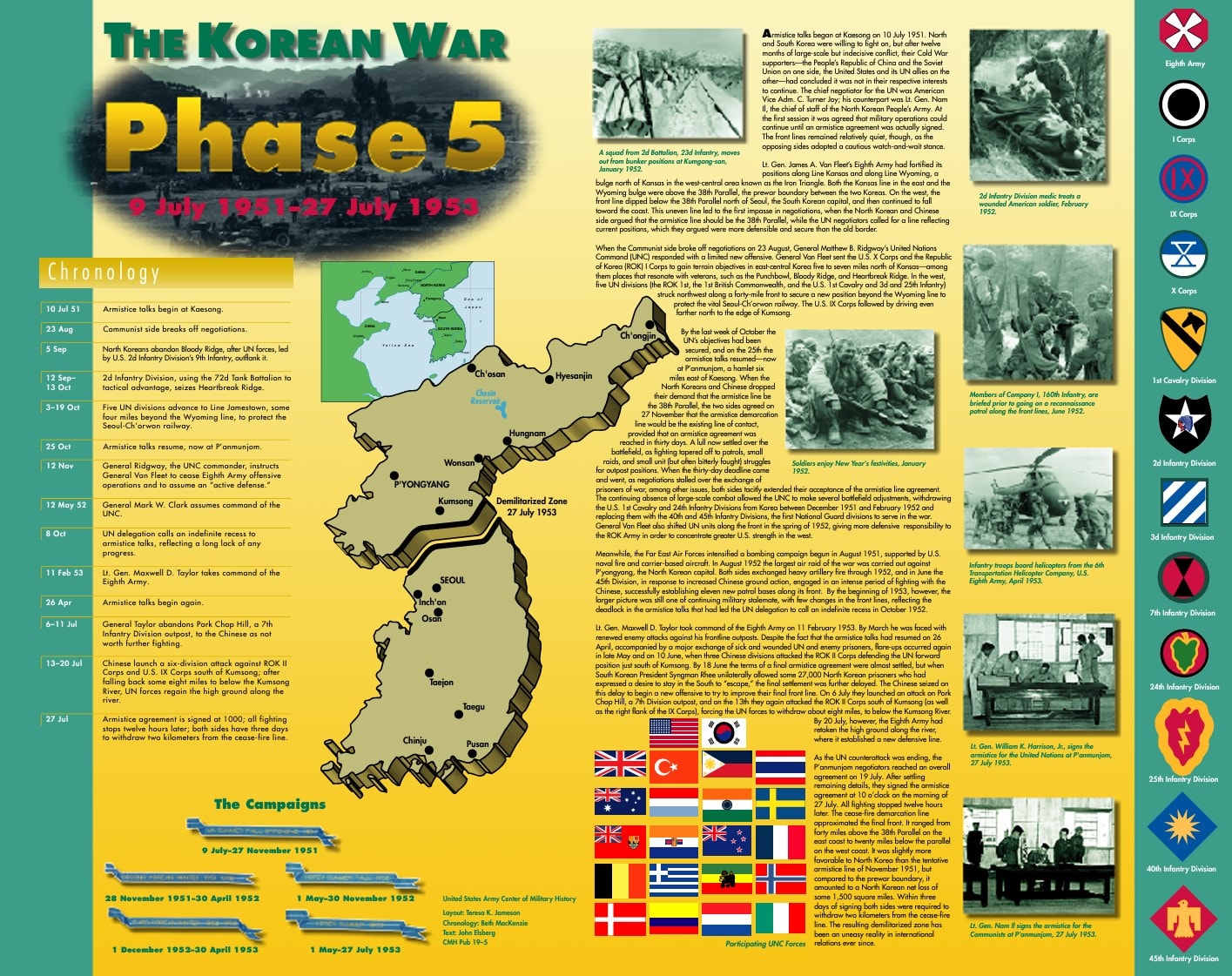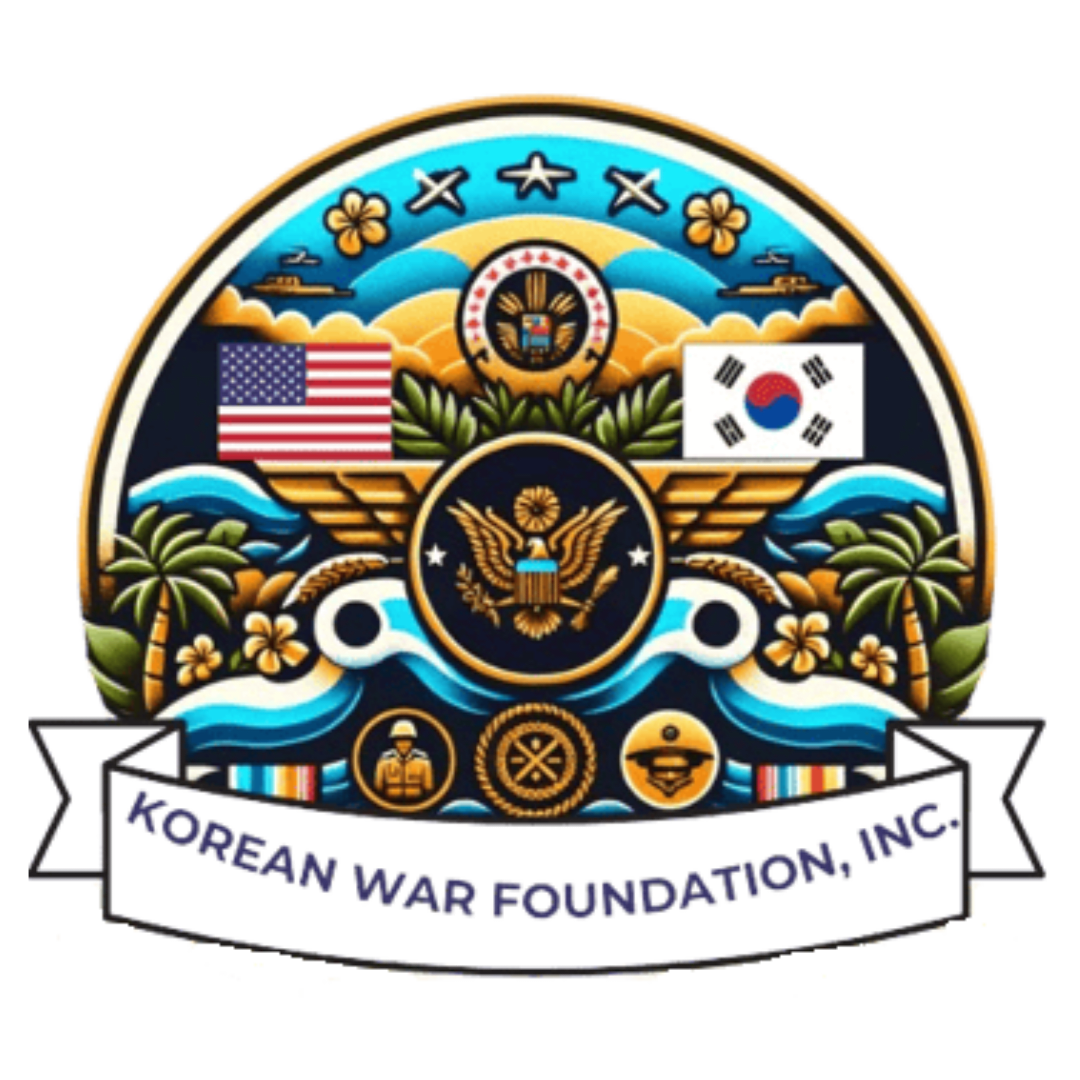Legacy Unveiled
Step into the past and witness the living legacies of courage, sacrifice, and honor. Our "Legacies Page" is a portal to stories that transcend time, connecting you with the heroes who defined an era.
Collaboration & Cooperation

Global Collaboration & Cooperation

Korean War Foundation, Inc. (KWFI) would like to work with everyone. We believe that we can accomplish anything when community, business and government all work together.
Visit Korean War Foundation, Inc.
Korean War Veterans Association, Inc.

Korean War Foundation, Inc. (KWFI) would like to do joint projects with Korean War Veterans Association, Inc. (KWVA).
Visit Korean War Veterans Association website
KWVA - A Brief History
The Korean War Veterans Association (KWVA) is a federally-tax exempt organization that was incorporated in the State of New York on June 25, 1985, at the principal address: 302 Middletown Road, Waterford (Saratoga County), New York. The KWVA is registered under the identification number "EPTL No. 03-78-18" in the Office of the Attorney General, Charities Bureau, 120 Broadway, New York, NY 10271. Its original founder was Mr. William T. Norris of New York, a member of F Company, 27th Infantry Regiment (Wolfhounds), 25th Infantry Division, when he served as a sergeant in the Korean War.
According to the incorporation papers, the corporation was formed for seven purposes. They included:
1. To organize, promote and maintain for benevolent and charitable purposes an association of persons who have seen honorable service during the Korean War at any time between June 25, 1950 and 31 January 1955, both dates inclusive, and of certain other persons, the particular qualifications for membership to be set forth in the By-laws of the Korean War Veterans Association.
2. To grant charters to groups of members at large of the Association.
3. To provide a means of contact and communication among the members of the Association.
4. To promote the establishment of, and to establish war and other memorials commemorative of any person or persons who served in the Korean War.
5. To aid needy Association members and their wives and children, and the widows and children of persons who were members at the time of their death.
6. To establish and maintain a national headquarters.
7. To do any and all things necessary or proper for the accomplishment of the foregoing business and objects of the Association, including, for such purposes, to contract and pay for personal and other services, to contract for, buy, take by deed, gift or devise, hold, possess, manage, borrow, rent, lease, loan, assign, convey, sell, and dispose of in any manner real and personal property, and to act as trustee, or be a beneficiary of a trust.
The original number of trustees in the first year of the Korean War Veterans Association’s existence was nine. The founding officers listed on the "Registration of Charitable Trust or Charitable Corporation" papers were: William T. Norris, President; Mario Scarcelletta, 1st Vice President; Arthur Patterson, 2nd Vice President; William Coe, Director; John Herbert, Treasurer; Kenneth Dame, Director; and Arthur L. DeVoe Jr., Director. The first issue of Graybeards (January, 1986), edited by William T. Norris, also said that Ira J. Singer and Edward Hoth were directors for 1985, along with Dame. Directors for 1986 were Robert F. Marchillo, DeVoe, and Stanley E. Hadden. Directors for 1987 were Coe, Dale W. Riggs, and Joseph A. Ricker. The historians were William Kingston, Jr. and Victor Gerst, Jr.
Korean War Veterans Digital Memorial
One of the greatest friends of the KWVA is Dr Jongwoo Han... He is a young professor at Syracuse University in New York. Dr. Han has been very innovative and working extremely hard promoting the legacy of our Korean War Veterans since he first approached the KWVA in 2011 at the annual convention in Boston.
His first "creation" was the Korean War Veterans Digital Memorial (KWVDM), which, in his words, "emerges as a first-of-its-kind project seeking to permanently preserve, unedited, the first-hand memories, experiences, and artifacts of our Korean War Veterans in an effort to pass them down to future generations."
Dr Han has also created a "companion project" for building "Teaching Tools" to be used by school teachers across the nation and world, to also promote the legacy of our Korean War Veterans. It is called "The Korean War Legacy Project"
Visit The Korean War Legacy Foundation Overview Video
Korean War Veterans Association, Inc. Hawaii Chapter #1
Korean War Veterans Association, Inc. Hawaii Chapter #1 was incorporated in the State of Hawaii on December 18, 1997.
December 8, 2023 newly elected officers are Mr. Robert M. Imose as president, Mr. Brian Lau as vice president, Mr. Walter M. Ozawa as secretary and Mr. Thomas T. Tahara as treasurer.
University Of Hawaii Hamilton Library Korean Collection

Korean War Foundation, Inc. (KWFI) is working with University of Hawaii Hamilton Library Ms. Ellie Kim to develop a Korean War collection.
Visit Korean collection website at
Korean War Legacy Foundation
Korean War Foundation, Inc. (KWFI) would like to do joint projects with Korean War Legacy Foundation focusing on the Korean war veterans from Hawaii. The goal of the Korean War Legacy Project is to assist teachers, students, and the general public in understanding the origins and outcomes of the Korean War, the challenges that soldiers faced while fighting it, and its rich legacy promoting democracy and freedom in the world today, which is exemplified by South Korea’s simultaneous achievement of rapid economic development and substantive democratization in late 20th century.
Due to the enormity of World War II and the controversial nature of Vietnam, the Korean War is widely under-appreciated by American educators, politicians, and the general public. In history textbooks, it is often referred to as the “forgotten war” and is described in just a few negligible paragraphs.
While the dynamics, impact, and legacy of the Korean War are often neglected in the historical record, South Korea and its people stand as a beacon of democracy within an increasingly turbulent world. In many contexts, the war is treated as an unfortunate stalemate. However, the reality is that United Nations intervention in Korea was a great success that helped create a strong nation and fostered alliances that last to this day. In fact, the Korean War is the only example of post WWII United States military intervention that resulted in a nation with a strong democracy and economy as well as a solid alliance between these two countries.
Visit Korean War Legacy Foundation website
Sergeant Leroy Anthony Mendonca Medal Of Honor Recipient

Sgt. LeRoy A. Mendonca, distinguished himself by conspicuous gallantry above and beyond the call of duty in action against the enemy. After his platoon, in an exhaustive fight, had captured Hill 586, the newly won positions were assaulted during the night by a numerically superior enemy force. When the 1st Platoon positions were outflanked and under great pressure and the platoon was ordered to withdraw to a secondary line of defense, Sgt. Mendonca voluntarily remained in an exposed position and covered the platoon's withdrawal. Although under murderous enemy fire, he fired his weapon and hurled grenades at the onrushing enemy until his supply of ammunition was exhausted. He fought on, clubbing with his rifle and using his bayonet until he was mortally wounded. After the action it was estimated that Sgt. Mendonca had accounted for 37 enemy casualties. His daring actions stalled the crushing assault, protecting the platoon's withdrawal to secondary positions, and enabling the entire unit to repel the enemy attack and retain possession of the vital hilltop position. Sgt. Mendonca's extraordinary gallantry and exemplary valor are in keeping with the highest traditions of the U.S. Army.
- RANK: SERGEANT
- CONFLICT/ERA: KOREAN WAR
- UNIT/COMMAND:
COMPANY B, 7TH INFANTRY REGIMENT,
3D INFANTRY DIVISION - MILITARY SERVICE BRANCH: U.S. ARMY
- MEDAL OF HONOR ACTION DATE: JULY 4, 1951
- MEDAL OF HONOR ACTION PLACE: NEAR CHICH-ON, KOREA
- ACCREDITED TO: HONOLULU, HONOLULU COUNTY, HAWAII
- AWARDED POSTHUMOUSLY: YES
- PRESENTATION DATE & DETAILS: AUGUST 14, 1952THE PENTAGON, PRESENTED BY GEN. OMAR N. BRADLEY TO HIS FATHER, JOSEPH MENDONCA
- BORN: AUGUST 2, 1932, HONOLULU, HONOLULU COUNTY, HI
- DIED: JULY 4, 1951, KOREA
- BURIED: NATIONAL MEMORIAL CEMETERY OF THE PACIFIC (PUNCHBOWL) (MH) (Q-1408), HONOLULU, HI, UNITED STATES
Leroy A. Mendonca (August 2, 1932 – July 4, 1951) was a soldier in the United States Army during the Korean War. He posthumously received the Medal of Honor for his actions on July 4, 1951.
Early life
Leroy was born in Honolulu, Territory of Hawaii, on 2 August 1932, and was of Portuguese ancestry. While attending President William McKinley High School, he was an AJROTC cadet, and graduated in 1950.
Honors
In 2001, the Bob Hope-class roll on roll off vehicle cargo ship USNS Mendonca was commissioned in the Military Sealift Command, and named in honor of Sergeant Mendonca

The Military Sealift Command large, medium-speed roll-on/roll-off surge sealift ship USNS Mendonca (T-AKR-303) performs tactical formation maneuvers in the North Atlantic Ocean on 24 September 2019. The simulated convoy maneuvers were part of U.S. Transportation Command's turbo activation, which was designed to test the surge sealift fleet's material readiness and its crews' ability to sail their ships in a contested environment.
Private First Class Herbert Kailieha Pilihaau Medal Of Honor Recipient

Pfc. Pililaau, a member of Company C, distinguished himself by conspicuous gallantry and outstanding courage above and beyond the call of duty in action against the enemy. The enemy sent wave after wave of fanatical troops against his platoon which held a key terrain feature on "Heartbreak Ridge." Valiantly defending its position, the unit repulsed each attack until ammunition became practically exhausted and it was ordered to withdraw to a new position. Voluntarily remaining behind to cover the withdrawal, Pfc. Pililaau fired his automatic weapon into the ranks of the assailants, threw all his grenades, and, with ammunition exhausted, closed with the foe in hand-to-hand combat, courageously fighting with his trench knife and bare fists until finally overcome and mortally wounded. When the position was subsequently retaken, more than 40 enemy dead were counted in the area he had so valiantly defended. His heroic devotion to duty, indomitable fighting spirit, and gallant self-sacrifice reflect the highest credit upon himself, the infantry, and the U.S. Army.
- RANK: PRIVATE FIRST CLASS
- CONFLICT/ERA: KOREAN WAR
- UNIT/COMMAND:
COMPANY C, 23D INFANTRY REGIMENT,
2D INFANTRY DIVISION - MILITARY SERVICE BRANCH: U.S. ARMY
- MEDAL OF HONOR ACTION DATE: SEPTEMBER 17, 1951
- MEDAL OF HONOR ACTION PLACE: NEAR PIA-RI, KOREA
- ACCREDITED TO: HONOLULU COUNTY, HAWAII
- AWARDED POSTHUMOUSLY: YES
- PRESENTATION DATE & DETAILS: MARCH 26, 1952THE PENTAGON, PRESENTED BY SEC. OF THE ARMY FRANK C. PACE TO HIS FATHER
- BORN: OCTOBER 10, 1928, WAIANAE, HONOLULU COUNTY, HI
- DIED: SEPTEMBER 17, 1951, KOREA
- BURIED: NATIONAL MEMORIAL CEMETERY OF THE PACIFIC (PUNCHBOWL) (P-127), HONOLULU, HI, UNITED STATES
- LOCATION OF MEDAL: U.S. ARMY MUSEUM OF HAWAII, FORT DERUSSY, WAIKIKI, HI
Herbert Kailieha Pililaʻau (October 10, 1928 – September 17, 1951) was a United States Army soldier and a recipient of the United States military's highest decoration, the Medal of Honor, for his actions in the Korean War. A Native Hawaiian who was born and raised on the island of Oʻahu, he was drafted into the military as a young man. Sent to Korea in early 1951, Pililaau participated as an automatic rifleman in the Battle of Bloody Ridge. During the subsequent Battle of Heartbreak Ridge, he voluntarily stayed behind to cover his unit's withdrawal in the face of an intense attack by North Korean forces. Alone, Pililaau held off the assault using his automatic rifle and hand grenades and, after exhausting all available ammunition, engaged the attackers in hand to hand combat until being overrun and killed. For these actions, Pililaau was posthumously awarded the Medal of Honor.
Early life
Pililaʻau was born and raised in Waiʻanae to William Kaluhi Pililaʻau and Abigail Keolalani Kailieha, in a working-class suburb of the Leeward coast of Oahu in what was then the Territory of Hawaii.[1] He was the ninth of 14 children, nine brothers and five sisters.[2] Pililaʻau's parents were both Native Hawaiians and his mother, Abigail, spoke English and Hawaiian. She was the daughter of Luka (Kailieha) Norton. Pililaʻau was a talented singer and ukulele player as well as an avid reader. After graduating from Waipahu High School in 1948, Pililaʻau studied administration, secretarial work, and accounting at Cannon Business School.
Military service
Drafted into the Army, Pililaʻau attended basic training at Fort Shafter. He briefly considered declaring himself a conscientious objector, as his Christian faith made him unsure of killing others but decided against this idea. Pililaʻau was sent to Korea in March 1951 and served as a private first class with Company C, 23rd Infantry Regiment, 2nd Infantry Division. Volunteering to be his squad's automatic rifleman, Pililaʻau carried a Browning Automatic Rifle (BAR). In August, Pililaʻau participated in the Battle of Bloody Ridge, in which the 2nd Infantry Division attacked and captured a ridge in east central Korea. Their next objective was a hill mass just to the north, near Pia-ri, which would come to be known as Heartbreak Ridge.[1]
On September 17, 1951, Company C and two other companies were tasked with capturing Hill 931, one of Heartbreak Ridge's two identifiable peaks, from North Korean forces. When Company C's attack stalled on a ridgeline which ran south from the main peak, Pililaʻau's platoon set up a defensive perimeter ahead of the rest of the company. With the help of artillery, mortar, and heavy machine gun support, the platoon easily held off a series of probing assaults which began in the mid-afternoon. At about 10:00 p.m., two battalions of the 13th Infantry Regiment, 6th Division, Korean People's Army, began a concerted attack on the position. With North Korean artillery striking close by and ammunition running low, the platoon caught in cross fire in the rice paddies received permission to withdraw and rejoin the main body of the company as quickly as possible. Pililaʻau's squad was assigned to stay back momentarily and cover the retreat. Eventually, only Pililaʻau and his squad leader remained at the platoon's original position. The squad leader and forward observer Lt. Richard Hagar called in artillery fire continuously ahead of Pililaʻau, trying to cover him while he moved also calling fire on the two hill tops, while Pililaʻau continued to fight off the attack. At one point, Hagar became afraid that the artillery was too close and that he hit Pililaʻau. Hagar called out for him, and Pililaʻau said he was okay and told Hagar to keep going. After exhausting the ammunition for his BAR, Pililaʻau began throwing hand grenades until those too were gone. As some of his comrades watched from their new position further down the ridge, Pililaʻau threw rocks at the attackers before charging at them, wielding his trench knife with one hand and punching with the other. He was soon surrounded and killed by bayonet. At this point, Hagar fell back to rejoin his troops. When his platoon retook the position the next day, they found 40 dead North Korean soldiers around his body.
Legacy and honors
Aged 22 at his death, Pililaʻau was buried at the National Memorial Cemetery of the Pacific in Honolulu on February 26, 1952. For his actions on Heartbreak Ridge, he was posthumously awarded the Medal of Honor later that year, on June 18. He was the first Hawaiian to receive the Medal of Honor.
In January 2000 in New Orleans, the United States Navy christened a Military Sealift Command cargo ship, the USNS Pililaau (T-AKR-304), in Pililaʻau's honor.[5] Thirty-one members of his extended family were given a tour of the ship on December 10, 2003, when it made its first docking in Hawaii. Also named for Pililaʻau are a live-fire range at Makua Military Reservation, a park in his hometown of Wai'anae, and the Pililaau Army Recreation Center.

The USNS Pililaau sits anchored off the Pacific coast at Camp Pendleton, Calif., July 22, during Joint Logistics Over The Shore 2008. JLOTS is an annual exercise that increases the Army's and Navy's ability to build improvised ports for transporting equipment from ship to shore when a harbor or pier has been damaged or is nonexistent. Nearly 1,500 pieces of rolling equipment and shipping containers will be moved from ships with a series of lighterage systems (floating roadways) and smaller boats to improvised piers on the shore. (U.S. Army photo by Sgt. Stephen Proctor, JLOTS Public Affairs)
Private First Class Anthony Kaho'ohanohano Distinguished Service Cross Recipient
Medal of Honor Monday: Army Pfc. Anthony Kaho'ohanohano
June 15, 2020 | By Katie Lange , DOD News
Long before Hawaii became a state, men from the island territory joined the United States military, including during World War II and the Korean War. One of Hawaii's native sons, Army Pfc. Anthony Kaho'ohanohano, fought in the latter conflict. His brave solo stand against an overwhelming enemy force led to his death, but it also earned him the Medal of Honor.
Kaho'ohanohano was born on Maui, Hawaii, on July 22, 1930. He grew to be a tall kid and was known by several of his siblings to be a quiet guardian to them. He loved swimming, going to the ocean and playing basketball.
Service was important to the family. Kaho'ohanohano's father had served in the military and was a dedicated police officer. His five brothers joined the military when they were old enough, and Kaho'ohanohano did the same. He enlisted in the Hawaii National Guard after high school.
On Feb. 5, 1951, several months after the Korean War began, he joined the regular Army. Kaho'ohanohano was assigned to Company H of the 17th Infantry Regiment, 7th Infantry Division based in Korea.
In August 1951, his unit was deployed to the front lines of the war. By the end of that month, an operation known as the Battle of Chup'a-ri was launched. Over the next several days, Kaho'ohanohano's unit fought for strategic hills in action that would shape the course of the war.
On Sept. 1, 1951, Kaho'ohanohano was in charge of a machine gun squad that was supporting his company’s defensive position when a large enemy force attacked. The Americans were overwhelmed, so they started to retreat. Kaho'ohanohano ordered his squad to fall back, too, and find more defensible positions so they could provide cover for the retreating men.
Kaho'ohanohano had been hit in the shoulder during the attack, but he chose to stay behind as his men moved to safety. He gathered up as much ammunition and as many grenades as he could find, then went back to his original position to face the enemy alone.
The North Koreans were determined to overrun his position, but he wasn't about to give it up easily. Kaho'ohanohano blasted the onrushing enemy with machine gun fire and grenades. When he ran out of both, he grabbed the only weapon he had left — a shovel — and fought his aggressors one on one until there were too many for him to handle. The position was overrun, and Kaho'ohanohano was killed.
When his unit heard about his heroic stand, they were inspired. The company launched a counterattack that was eventually able to repel the enemy soldiers.
When Kaho'ohanohano's fellow soldiers found his body, they were amazed by what they found with it: 11 enemy soldiers lay dead in front of his position, while two others that the 21-year-old had fought in hand-to-hand combat lay dead beside him. Kaho'ohanohano's machine gun had fired so many times that its barrel was bent.
For his selfless actions, Kaho'ohanohano was posthumously awarded the Distinguished Service Cross, the nation’s second-highest military honor. But his family and many in his community thought he deserved more. So, after decades of petitioning for a higher honor from World War II veterans and fellow Hawaiians, U.S. Sens. Danny Akaka and Dan Inouye, it was decided the award would be upgraded to the Medal of Honor.
On May 2, 2011, President Barack Obama presented the Medal of Honor to Kaho'ohanohano's sister, Elaine, and brother, Eugene, at a White House ceremony. Nearly 30 more members of Kaho'ohanohano's family attended, as did several Korean War veterans.
"Kaho'ohanohano will always be remembered for the lone assault that saved his comrades, and then inspired their counterattack," Deputy Defense Secretary William J. Lynn III said at a ceremony at the Pentagon the day after the White House presentation. "His last words — reportedly, 'I've got your back,' — are a creed our soldiers carry with them today whenever they go into harm’s way."
Kaho'ohanohano's spirit lives on in his native Hawaii. A National Guard armory was named for him in the village of Puunene on his home island of Maui.
This article is part of a weekly series called "Medal of Honor Monday," in which we highlight one of the more than 3,500 Medal of Honor recipients who have earned the U.S. military's highest medal for valor.
Medal of Honor: Army Pfc. Anthony Kaho'ohanohano
U.S. Military Fatal Casualties of the Korean War for Home-State-of-Record: Hawaii
U.S. Military Non-Fatal Casualties of the Korean War for Home-State-of-Record: Hawaii
Sergeant First Class Alepio Solmirin Purple Heart Recipient
Local Soldier Awarded Purple Heart Posthumously
By Civil Beat / June 2, 2012
Nearly 60 years after being wounded on the field of battle, a Waipahu man who served in in the Korean war has been posthumously awarded a Purple Heart.
Due to an oversight, Sergeant First Class Alepio Solmirin was never credited for his injuries. He retired from the Army after 25 years and has since passed away. Solmirin’s family has tried many times to correct the error.
KITV reports that it wasn’t until Solmirin’s son, Adam, a maintenance worker for the quarters on Palm Circle, approached Lt. Gen. Wiercinski, Commander, U.S. Army Pacific. With the help of his staff, Wiercinski tracked down the missing records.
Solmirin’s family was presented with the medal on Friday.
Private First Class Thomas Tanaka Purple Heart Recipient

Thomas Tanaka
Thomas Tanaka was drafted into the U.S. Army in November 1950 and was assigned to the 24th
Division, 19th Regiment.
In October 1951, PFC Tanaka was wounded-in-action by a North Korean mortar in Kumsong,
North Korea.
Along with his Purple Heart, PFC Tanaka was awarded the Korean Service Medal with Bronze
Service Star, and the United Nations Service medal.
After leaving the Army, Tanaka worked for the U.S. Postal Service and became involved in
veterans causes. He is a former commander for the Military Order of the Purple Heart
Department of Hawaii Chapter 483. Tanaka was nominated for the Patriot Project by fellow
Purple Heart recipient Robert Cox, Hawaii’s honoree during the 2019 Purple Heart Patriot Project.
The Korean War Chronology
The Korean War Phase 1: June 27, 1950 to September 15, 1950
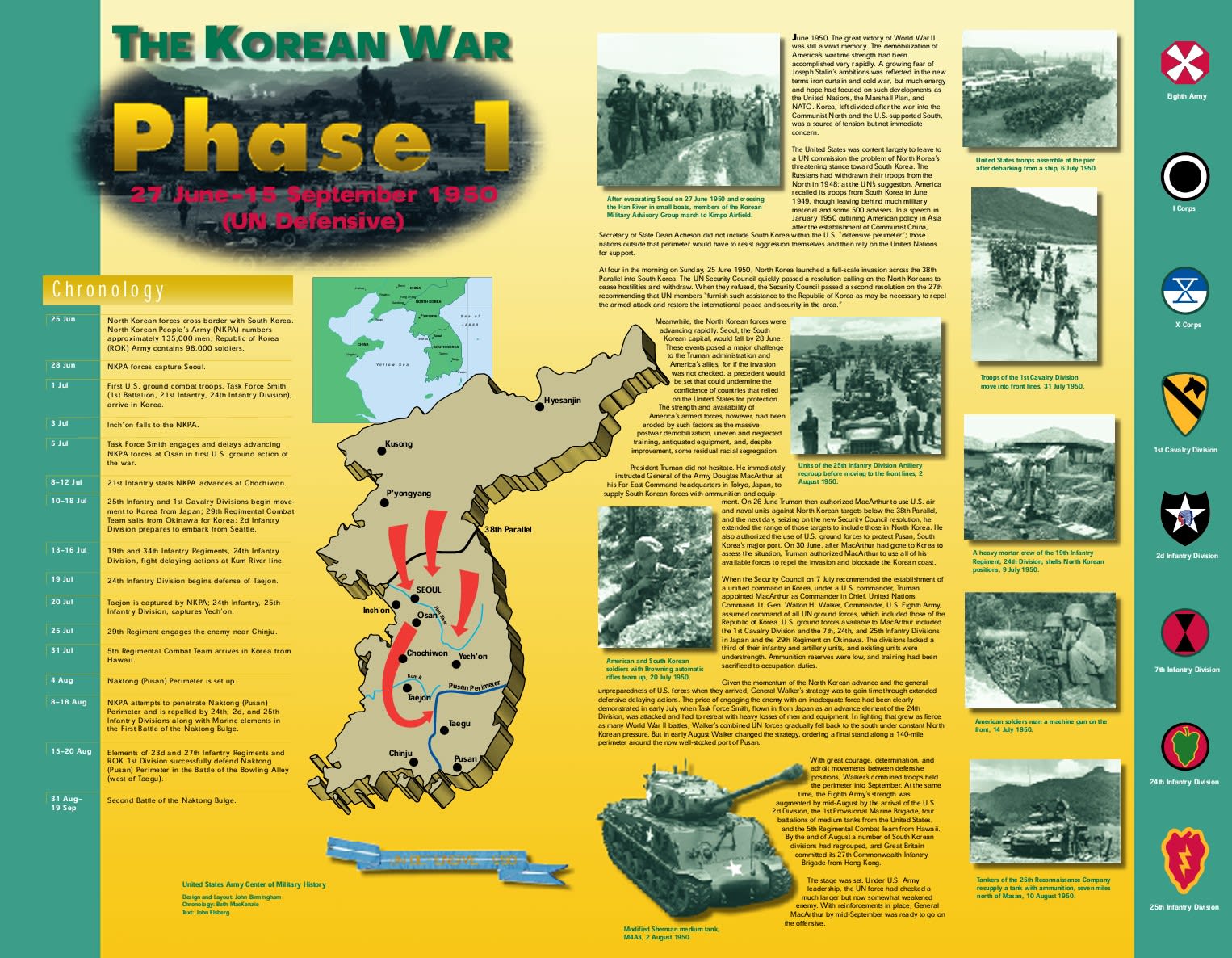
The Korean War Phase 2: September 16, 1950 to November 2, 1950
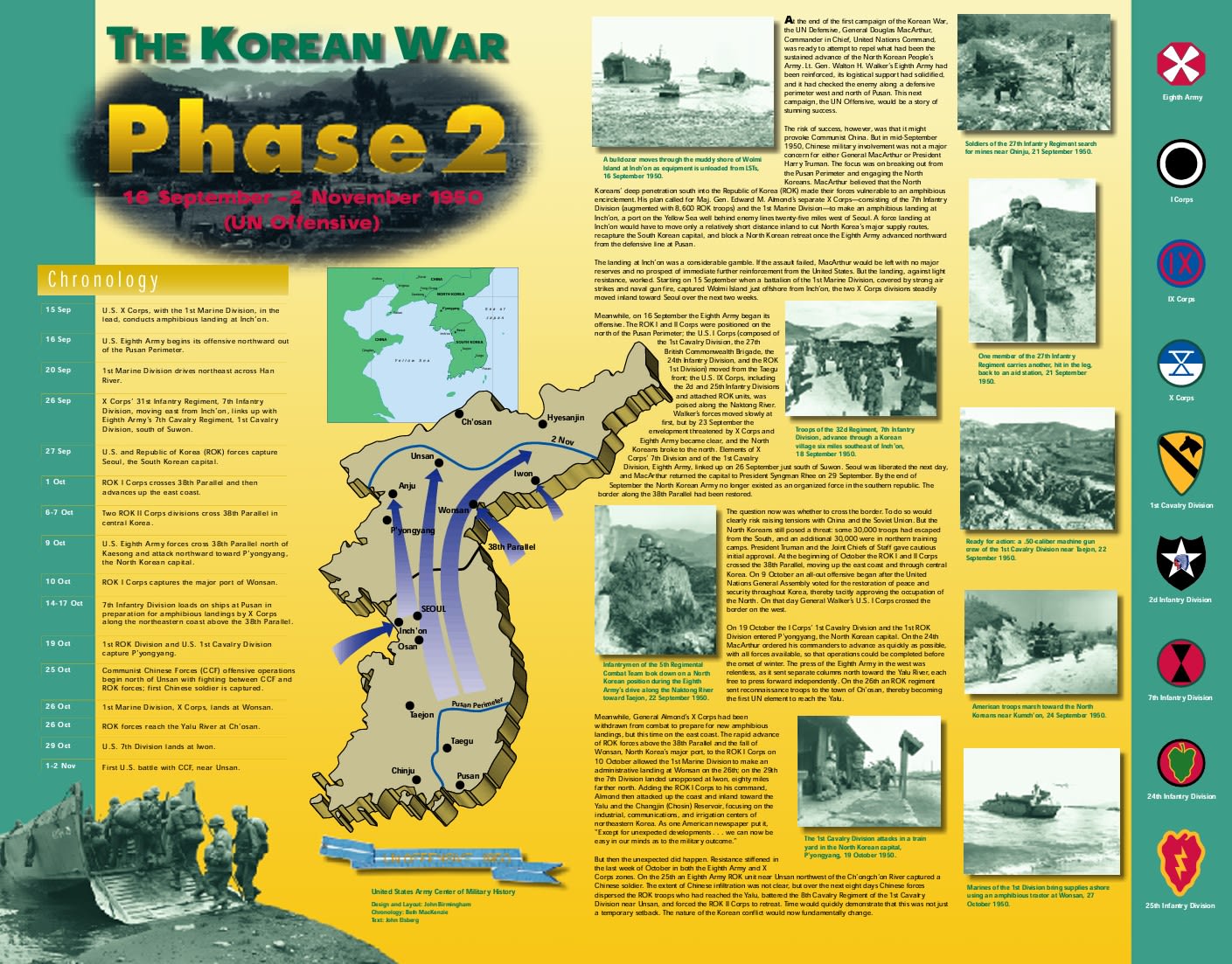
The Korean War Phase 3: November 3, 1950 to January 24, 1951
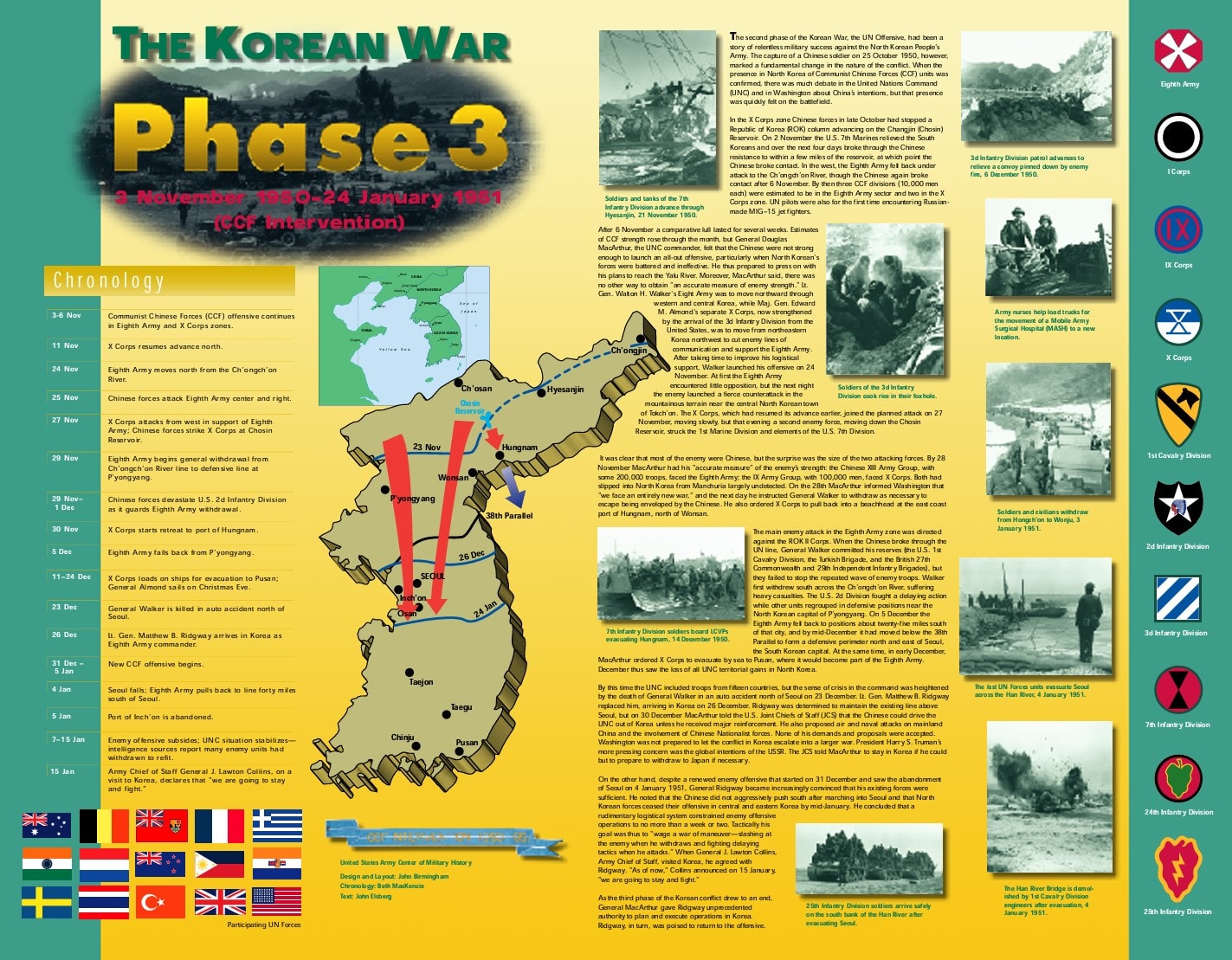
The Korean War Phase 4: January 25, 1951 to July 8, 1951
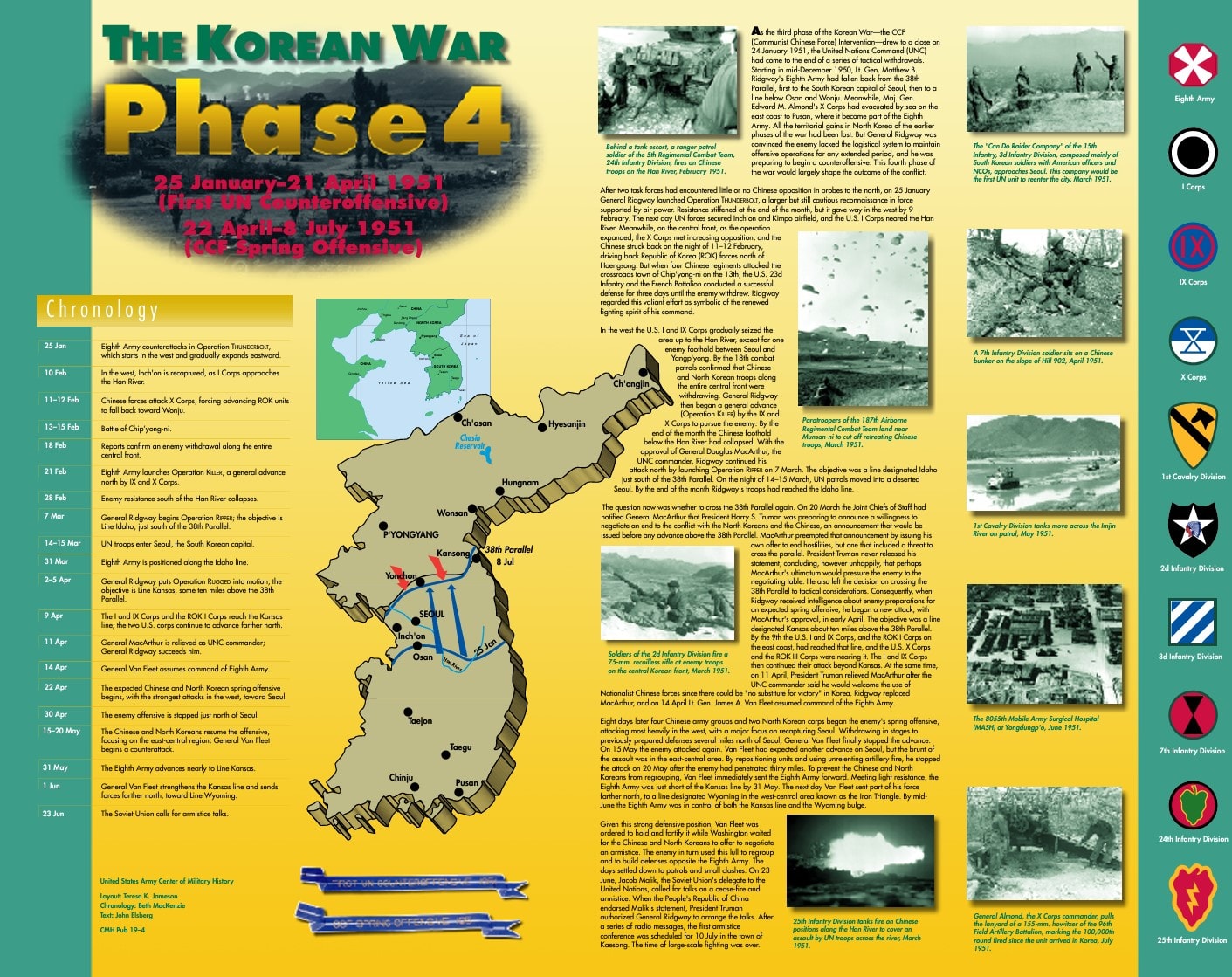
The Korean War Phase 5: July 9, 1951 to July 27, 1959
